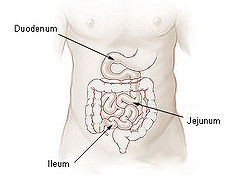- Duodenojejunal flexure
-
Duodenojejunal flexure 
Superior and inferior duodenal fossæ. 
Small intestine Latin flexura duodenojejunalis Gray's subject #248 1170 The duodenojejunal flexure or duodenojejunal junction is the border between the duodenum and the jejunum.
The ascending portion of the duodenum ascends on the left side of the aorta, as far as the level of the upper border of the second lumbar vertebra, where it turns abruptly forward to become the jejunum, forming the duodenojejunal flexure.
It lies in front of the left Psoas major and left renal vessels, and is covered in front, and partly at the sides, by peritoneum continuous with the left portion of the mesentery.
The ligament of Treitz, a peritoneal fold, from the right crus of diaphragm, is an identification point for the duodenojejunal flexure at operation.[1]
Contents
Additional images
See also
References
- ^ Jacob,S. (2007) Chapter 4: Abdomen; Human anatomy, A clinically-orientated approach. P.85
External links
- SUNY Figs 37:06-04 - "The large intestine."
- SUNY Labs 39:07-0105 - "Intestines and Pancreas: The Duodenum"
- SUNY Anatomy Image 8155
- duodenojejunal+flexure at eMedicine Dictionary
- duodenojejunal+junction at eMedicine Dictionary
This article was originally based on an entry from a public domain edition of Gray's Anatomy. As such, some of the information contained within it may be outdated.
Categories:- Digestive system stubs
- Digestive system
Wikimedia Foundation. 2010.


